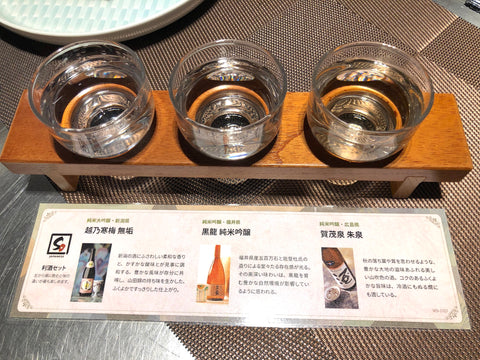Hello Japanese food lovers! Even for seasoned Japanese food enjoyers, sake is often described as an acquired taste.
But once acquired, it mesmerises continuously! 😊
If you’re feeling the tickle but are unsure of where to start, we have the perfect starter set…
The perfect introduction – Kikizake Sake Tasting Set

Our Kikizake Sake Tasting set of three different glasses of sake 50ml each, introduces you to three very different tastes and textures that will open your eyes wide to the infinite deeply mysterious and wonderful world of sake.
Firmly balanced Koshino kanbai Muku

We recommend starting at the left. Koshino kanbai Muku is made in Niigata prefecture, the most famous region for producing the much-loved brand of table rice, Niigata-san Koshihikari. The Ishimoto brewery is responsible for this sake that is described as ‘Classic Niigata sake with subdued aroma, nuanced acidity and perfect balance. Presents rich interplay of flavours and a satisfying finish.’
Rice that is used to make sake is called saka-mai. The most famous of them all and referred to as the kind of sakamai is Yamadanishiki rice, which is the grain used to make this sake.
The polishing ratio os Koshino kanbai Muku is 48%, meaning 52% of the outer shell has been removed. Sake made with higher polishing ratio rice is generally said to be more clear and aromatic, as the outer layer is composed of components hat interferes with build of aroma.
Sake made with rice polished more than 50% is called Daiginjo and are made in smaller quantities.

This beauty is exquisite paired with the likes of chef’s omakase sashimi selection, mackerel and fennel salad, and prawn tempura to name a few… 🍶
Deeply mysterious, rich and welcoming Kokuryu

Next up, the middle cup is the Kokuryu made in Fukui Prefecture by Kokuryu Sake Brewing Company.
Kokuryu “Junmai Ginjo” has the imposing presence of sakes brewed in the Noto Toji style of western Japan. Its deeply mysterious flavour seems to come from the earth itself: rich, dynamic and welcoming.
With a polishing ratio of 55%, this sake is a Ginjo but with no added alcohol so it is categorised as Junmai Ginjo. Using saka-mai called ‘Gohyaku mangoku’ that tends to produce light and clear sake.
This sake is delicious with hearty fare like braised meat, fish and root vegetables. Best enjoyed at 10–15 degrees, or warmed to 40–45 degrees. The whole kikizake sake tasting set is served at around 10 degrees for ease of comparison.

While sipping away on this one, we recommend dishes like salmon rikyu-yaki, grilled eel, and grilled yakitori chicken.
Rich, robust, with a woody shiitake aroma, Kamoizumi Shusen

Last up is Kamoizumi Shusen, made in Hiroshima Prefecture by Kamoizumi Brewing Company.
Clearly a darker shade, this one is a wild card in the sake deck. Kamoizumi has a woody, forest-floor aroma of autumn leaves and mushrooms. There is a lot to explore in this big-boned sake.
This one is a junmai, with a polishing ratio of 58%. Best paired with duck and fatty meat, mushrooms and winter vegetables. Pairs beautifully with our sauteés, miso marinated black cod and our super crunchy pork katsu.

Only made from just three ingredients, rice, water, and koji, the world of sake is deeply rich and astonishingly diverse. We invite you to take that life changing first step with us.
Welcome!


